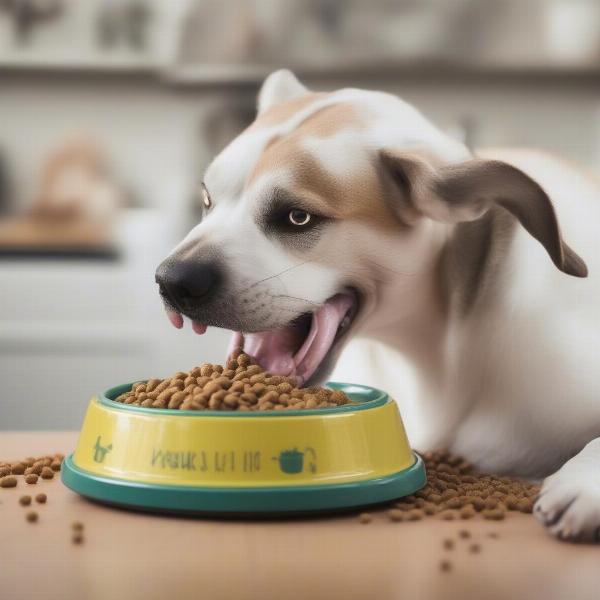Low fat dog food is often recommended for dogs with specific health conditions, such as pancreatitis, inflammatory bowel disease, or hyperlipidemia. Choosing the right low fat dog food can be a crucial step in managing these conditions and ensuring your furry friend’s overall well-being. This article will explore everything you need to know about low fat dog food, from understanding its benefits and identifying the right type for your dog, to navigating potential challenges and incorporating it into a healthy diet plan.
Understanding the Importance of Low Fat Dog Food
For dogs struggling with pancreatitis, excess fat in their diet can exacerbate inflammation and pain. Low fat dog food minimizes this risk, allowing the pancreas to rest and recover. Similarly, dogs with inflammatory bowel disease (IBD) often have difficulty digesting and absorbing fats. A low fat diet can alleviate digestive upset, improve nutrient absorption, and promote a healthier gut. Hyperlipidemia, a condition characterized by elevated levels of fats in the blood, can also benefit from a low fat diet, helping to regulate blood lipid levels and reduce the risk of associated health problems.
Choosing the Right Low Fat Dog Food
When selecting a low fat dog food, it’s essential to look for a product that meets your dog’s specific needs. Consult your veterinarian for personalized recommendations based on your dog’s breed, age, health condition, and activity level. low fat dog food for dogs with pancreatitis The fat content should be clearly stated on the label, typically expressed as a percentage on a dry matter basis. Look for options with a fat content of less than 10% on a dry matter basis. Ingredients should be high-quality and easily digestible. Avoid artificial colors, flavors, and preservatives.
Navigating Potential Challenges of Low Fat Dog Food
While low fat dog food offers numerous benefits, there are some potential challenges to be aware of. One concern is palatability. Some dogs may find low fat food less appealing than their regular diet.  Dog Eating Low Fat Food To address this, gradually transition your dog to the new food by mixing it with their current food over several days. Another challenge is ensuring adequate calorie intake, especially for active dogs. Low fat foods can be less calorie-dense, so you may need to feed your dog larger portions to meet their energy needs.
Dog Eating Low Fat Food To address this, gradually transition your dog to the new food by mixing it with their current food over several days. Another challenge is ensuring adequate calorie intake, especially for active dogs. Low fat foods can be less calorie-dense, so you may need to feed your dog larger portions to meet their energy needs.
Incorporating Low Fat Dog Food into a Healthy Diet Plan
Integrating low fat dog food into a healthy diet plan requires careful consideration. royal canin intestinal low fat dog food Monitor your dog’s weight and adjust portions as needed to maintain a healthy body condition. Supplementing with essential fatty acids under veterinary guidance can ensure your dog receives the necessary nutrients for skin and coat health. Regular veterinary check-ups are crucial to monitor your dog’s progress and make any necessary adjustments to their diet plan.
What are the signs my dog needs low fat dog food?
Your veterinarian will be the best judge, but signs like frequent vomiting, diarrhea, or abdominal pain could indicate a need for low fat food.
Can I make homemade low fat dog food?
Yes, but it’s crucial to consult a veterinary nutritionist to ensure the diet is balanced and meets all your dog’s nutritional needs.
Are there any side effects of low fat dog food?
While generally safe, some dogs may experience decreased energy levels or dull coat. iams low fat dog food Supplementation can often address these issues.
How do I transition my dog to low fat dog food?
Gradually mix the new food with their current food over 7-10 days, increasing the proportion of low fat food each day.
What are the best brands of low fat dog food?
Several reputable brands offer low fat options. royal canin gastrointestinal low fat dog food Your veterinarian can help you choose the right one for your dog.
How much low fat dog food should I feed my dog?
Follow the feeding guidelines on the product label and adjust based on your dog’s weight, activity level, and specific health needs.
Is low fat dog food suitable for all dogs?
No, low fat dog food is primarily intended for dogs with specific health conditions. Consult your veterinarian before switching your healthy dog to a low fat diet. low fat dog food for pancreatitis
In conclusion, low fat dog food plays a vital role in managing certain canine health conditions. By understanding the benefits, choosing the right product, and incorporating it thoughtfully into a balanced diet plan, you can help your dog thrive while managing their health concerns.
ILM Dog is your trusted international resource for expert canine care and nurturing advice. We offer comprehensive information on Dog Breeds & Selection, Health & Medical Care, Training & Behavior, Nutrition & Feeding, Grooming & Hygiene, and Products & Accessories. From puppyhood to senior care, we’re here to help you navigate every step of your dog ownership journey. Contact us for personalized guidance at [email protected] or +44 20-3965-8624. ILM Dog is dedicated to providing dog owners worldwide with the knowledge and resources needed to ensure their furry companions live long, healthy, and happy lives.